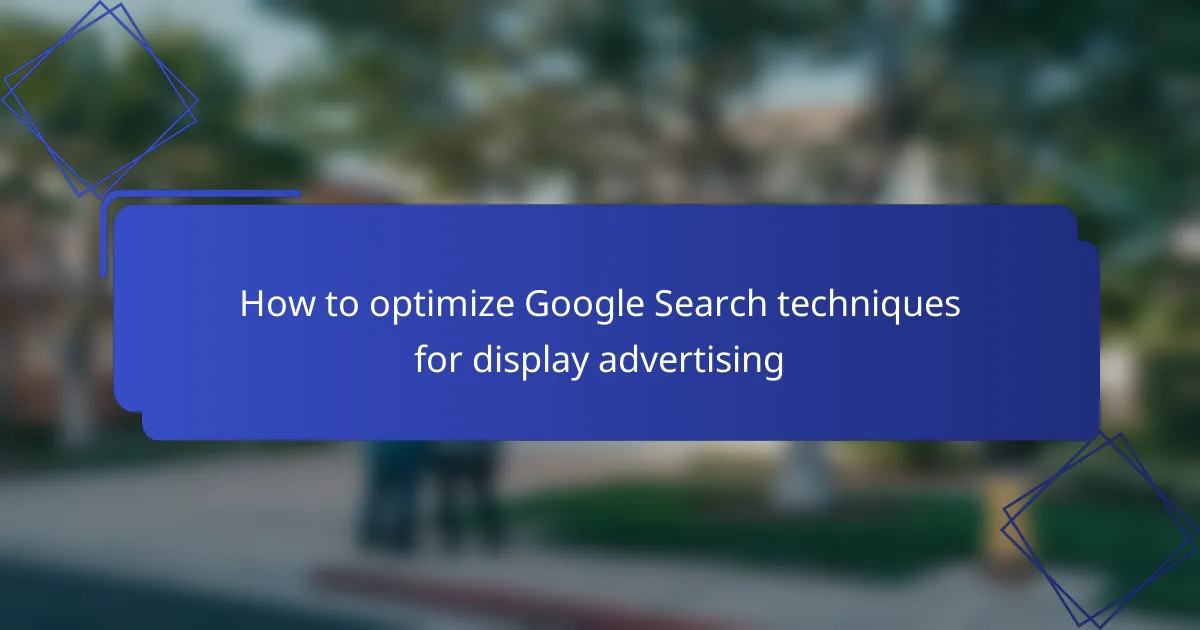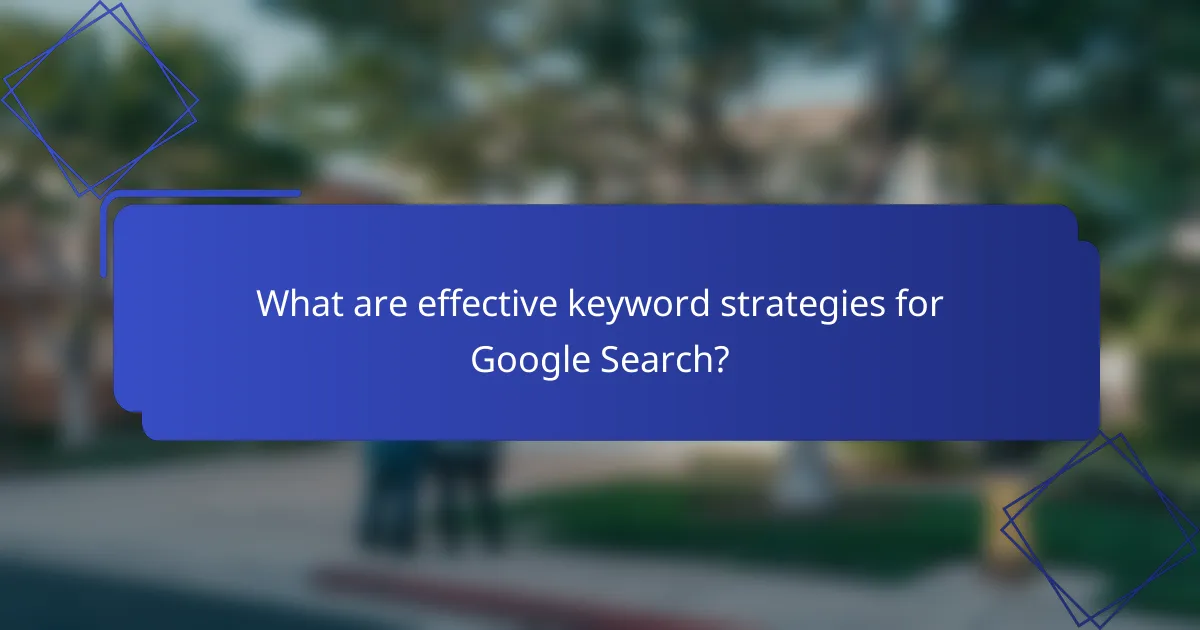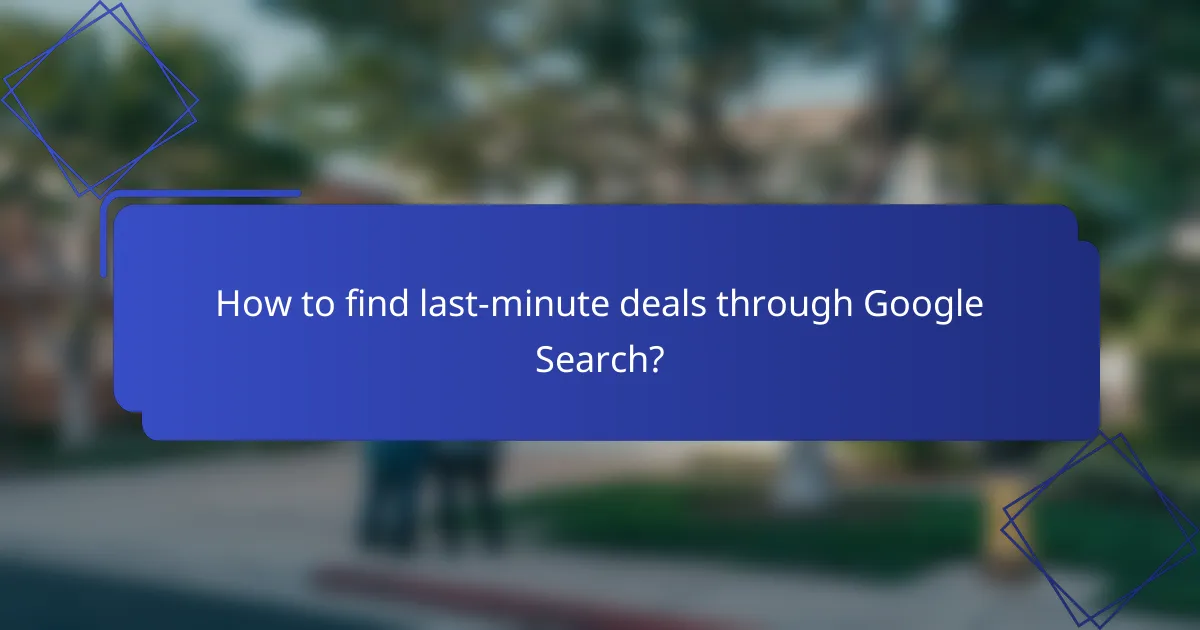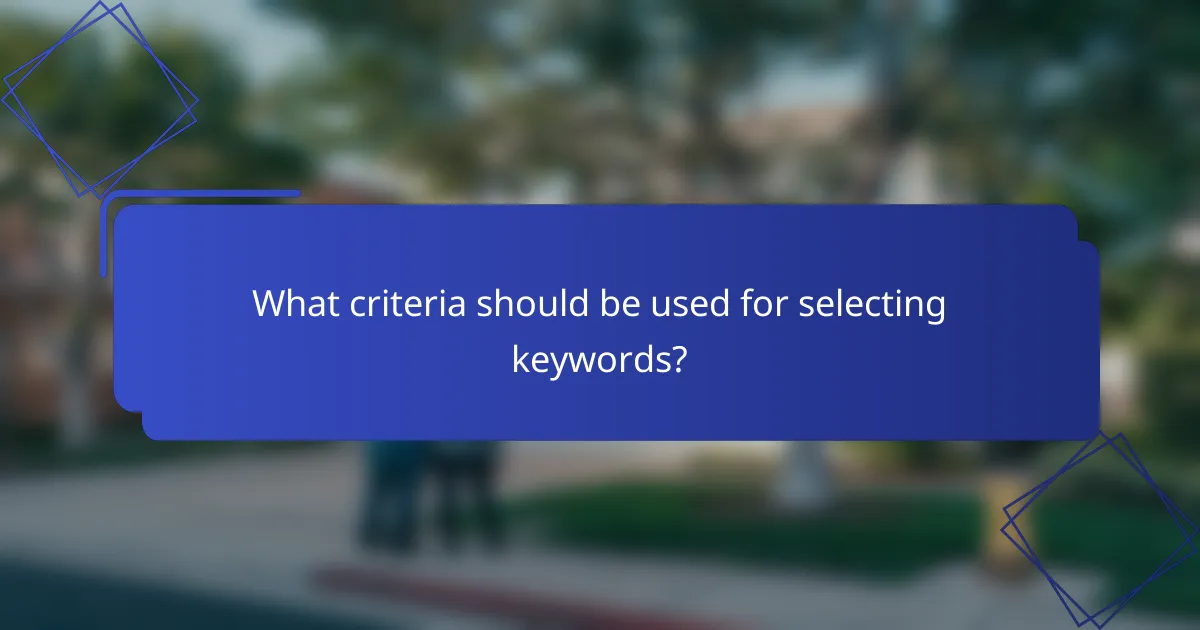Mastering Google Search techniques is essential for maximizing visibility and engagement in display advertising. By employing effective keyword strategies and optimizing content, advertisers can connect with their target audience more efficiently. Additionally, savvy users can discover last-minute deals by utilizing Google’s tools to compare prices and access exclusive promotions.

How to optimize Google Search techniques for display advertising
Optimizing Google Search techniques for display advertising involves leveraging effective keywords, SEO strategies, and content practices to enhance visibility and engagement. By focusing on these elements, advertisers can improve their ad performance and reach their target audience more effectively.
Keyword research tools
Keyword research tools are essential for identifying the terms your audience uses when searching online. Popular tools like Google Keyword Planner, SEMrush, and Ahrefs can help you discover high-volume keywords relevant to your products or services.
When using these tools, focus on long-tail keywords that are specific and less competitive. This approach can lead to higher conversion rates as these keywords often indicate stronger purchase intent.
On-page SEO strategies
On-page SEO strategies are crucial for optimizing your website to rank higher in search results. This includes optimizing title tags, meta descriptions, and header tags with relevant keywords to improve click-through rates.
Ensure that your content is structured well, with clear headings and subheadings. Use internal linking to guide users to related content, which can enhance user experience and keep visitors on your site longer.
Content optimization practices
Content optimization practices involve refining your website’s content to make it more appealing to both users and search engines. Focus on creating high-quality, informative content that addresses the needs and questions of your audience.
Incorporate relevant keywords naturally throughout your content, but avoid keyword stuffing. Aim for a keyword density of around 1-2% to maintain readability while still being optimized for search engines.
Link-building techniques
Link-building techniques are vital for improving your site’s authority and search rankings. Strategies include guest blogging, creating shareable infographics, and reaching out to influencers in your industry for collaborations.
Quality matters more than quantity; focus on acquiring links from reputable sites. A few high-quality backlinks can significantly impact your SEO more than numerous low-quality links.
Ad placement strategies
Ad placement strategies determine where your ads appear on search results and websites. Utilize Google Ads’ targeting options to place your ads on relevant sites and in front of the right audience segments.
Consider A/B testing different placements and formats to see which yield the best results. Monitor performance metrics like click-through rates and conversion rates to refine your strategy over time.

What are effective keyword strategies for Google Search?
Effective keyword strategies for Google Search involve selecting terms that align with user intent and optimizing content accordingly. This includes using a mix of long-tail keywords, local SEO keywords, and conducting competitive keyword analysis to enhance visibility and attract targeted traffic.
Long-tail keywords
Long-tail keywords are phrases that typically contain three or more words and are more specific than general keywords. They often have lower search volume but higher conversion rates because they target users further along in the buying process. For example, instead of using “shoes,” a long-tail keyword might be “best running shoes for flat feet.”
To effectively use long-tail keywords, incorporate them naturally into your content, headings, and meta descriptions. Aim for a balance between search volume and relevance, focusing on terms that your target audience is likely to use when searching for specific products or services.
Local SEO keywords
Local SEO keywords are essential for businesses that serve specific geographic areas. These keywords typically include the location in the search term, such as “pizza delivery in Boston” or “plumber in San Francisco.” By optimizing for local keywords, you can improve your chances of appearing in local search results and Google Maps listings.
To optimize for local SEO, include your city or region in your website’s content, title tags, and meta descriptions. Additionally, create a Google My Business profile and encourage customer reviews to enhance your local search visibility.
Competitive keyword analysis
Competitive keyword analysis involves researching the keywords that your competitors are targeting to identify opportunities for your own SEO strategy. This process can help you understand which keywords drive traffic to competitor sites and reveal gaps in your own keyword strategy.
Use tools like SEMrush or Ahrefs to analyze competitors’ keyword rankings and traffic sources. Focus on identifying keywords with a good balance of search volume and competition, and consider how you can create better content around those terms to gain an advantage.

How to find last-minute deals through Google Search?
Finding last-minute deals through Google Search is straightforward if you know where to look. Utilize various tools and features within Google to compare prices, access time-sensitive promotions, and leverage Google Shopping for the best offers.
Price comparison tools
Google offers several price comparison tools that can help you identify the best deals quickly. By entering specific product names or categories, you can see a range of prices from different retailers, allowing you to make informed decisions.
Consider using Google Shopping or third-party comparison websites that aggregate prices from multiple sources. This can save you time and money, especially when looking for electronics, travel, or home goods.
Time-sensitive promotions
Many retailers run time-sensitive promotions that can be discovered through Google Search. Look for keywords like “flash sale,” “limited time offer,” or “last-minute deals” to find discounts that are available for a short period.
Be proactive by setting alerts for specific products or categories. This way, you can receive notifications when deals become available, ensuring you don’t miss out on significant savings.
Google Shopping features
Google Shopping provides a robust platform for finding last-minute deals on various products. You can filter results by price, brand, and seller, making it easier to find the best offers that suit your needs.
Additionally, take advantage of the “Deals” section within Google Shopping, which highlights current promotions and discounts. This feature can be particularly useful for finding last-minute deals on travel, electronics, and seasonal items.

What criteria should be used for selecting keywords?
When selecting keywords, focus on search volume, competition level, and relevance to your target audience. These criteria help ensure that your chosen keywords will attract traffic and convert visitors effectively.
Search volume metrics
Search volume metrics indicate how often a keyword is searched within a specific timeframe, typically monthly. High search volume keywords can drive significant traffic, but they may also attract more competition. Aim for keywords with a balance of decent search volume and manageable competition.
Tools like Google Keyword Planner or SEMrush can provide insights into search volume. Look for keywords that fall within the low to mid thousands for a good starting point, as they often present opportunities for growth without overwhelming competition.
Competition level
Competition level refers to how many other websites are targeting the same keyword. Keywords with high competition can be difficult to rank for, while those with low competition may offer easier opportunities for visibility. Assessing competition helps you identify which keywords are worth pursuing.
Use tools to analyze competition, such as Moz’s Keyword Difficulty Tool. Target keywords with a competition score that aligns with your website’s authority; for newer sites, focusing on low to medium competition keywords is advisable.
Relevance to target audience
Relevance ensures that the keywords you select align with the interests and needs of your target audience. Choosing highly relevant keywords increases the likelihood of attracting visitors who are genuinely interested in your content or offerings. Always prioritize keywords that reflect the intent of your audience.
To determine relevance, consider conducting audience research or using social media insights. Keywords should not only match search queries but also resonate with the specific demographics and preferences of your audience, enhancing engagement and conversion rates.

What are the emerging trends in Google Search for 2024?
In 2024, Google Search is increasingly influenced by AI-driven algorithms, personalized search experiences, and the integration of multimedia content. These trends emphasize the importance of optimizing for user intent and adapting to evolving search behaviors.
AI-driven search algorithms
AI-driven search algorithms are transforming how Google processes and ranks content. These algorithms utilize machine learning to better understand user queries and context, allowing for more relevant search results. As a result, content creators must focus on producing high-quality, contextually relevant material that aligns with user intent.
To optimize for these algorithms, consider using structured data to enhance visibility in search results. Implementing schema markup can help Google better understand your content, potentially leading to rich snippets and improved click-through rates. Additionally, prioritize natural language processing techniques to ensure your content resonates with conversational queries.
Common pitfalls include over-optimizing for specific keywords, which can lead to penalties. Instead, focus on creating comprehensive content that addresses user needs and questions. Regularly update your content to keep it relevant, as AI algorithms favor fresh information. Aim for clarity and engagement to enhance user experience and search performance.



